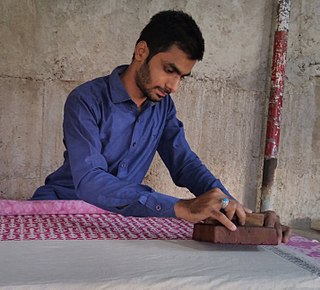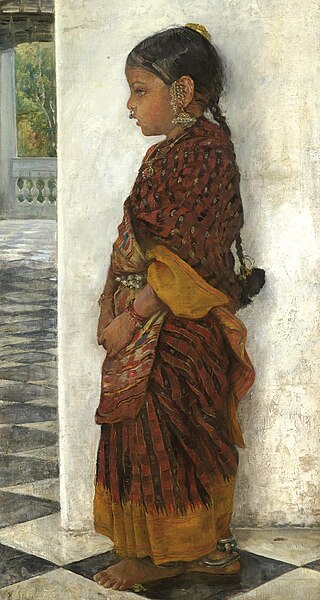Related Research Articles

Jamdani is a fine muslin textile produced for centuries in South Rupshi of Narayanganj district on the bank of Shitalakhwa river in what was Bengal and eventually became Bangladesh - see Partition of Bengal.

Khadi, derived from khaddar, is a hand-spun and woven natural fibre cloth promoted by Mahatma Gandhi as swadeshi (self-sufficiency) for the freedom struggle of the Indian subcontinent, and the term is used throughout India, Pakistan and Bangladesh. The first piece of the hand-woven cloth was manufactured in the Sabarmati Ashram during 1917–18. The coarseness of the cloth led Gandhi to call it khadi. The cloth is made from cotton, but it may also include silk or wool, which are all spun into yarn on a charkha. It is a versatile fabric that remains cool in summer and warm in winter. To improve its appearance, khadi is sometimes starched to give it a stiffer feel. It is widely accepted in various fashion circles. Popular dresses are made using khadi cloth such as dhoti, kurta, and handloom saris such as Puttapaka Saree, Kotpad Handloom fabrics, Chamba Rumal, and Tussar silk. Gajam Anjaiah, an Indian master handloom designer and a recipient of the Padma Shri, is known for his innovation and development of tie-dye handloom products along with the Telia Rumal technique of weaving products based on the Ikat process.

A Banarasi sari is a sari made in Varanasi, an ancient city which is also called Benares (Banaras). The saris are among the finest saris in India and are known for their gold and silver brocade or zari, fine silk and opulent embroidery. The saris are made of finely woven silk and are decorated with intricate design, and, because of these engravings, are relatively heavy.
Balaramapuram is one of the panchayats that form the city of Thiruvananthapuram, the capital of Kerala, India. It is the most urbanized panchayat in Thiruvananthapuram.

Phulkari refers to the folk embroidery of the Punjab. Although Phulkari means floral work, the designs include not only flowers but also cover motifs and geometrical shapes. The main characteristics of Phulkari embroidery are use of darn stitch on the wrong side of coarse cotton cloth with coloured silken thread. Punjabi women create innumerable alluring and interesting designs and patterns by their skilful manipulation of the darn stitch. According to Kehal (2009), a cloth where only a few flowers are embroidered is called a Phulkari. The other types are distinct varieties. The traditional varieties of Phulkaris are large items of cloth and include Chope, Tilpatr, Neelak and Bagh. Sometimes, the Bagh is given separate categorization of its own as on other varieties of a Phulkari, parts of the cloth is visible, whereas in a Bagh, the embroidery covers the entire garment so that the base cloth is not visible. Further, in contemporary modern designs, simple and sparsely embroidered dupattas, odhinis, and shawls, made for everyday use, are referred to as phulkaris, whereas clothing items that cover the entire body, made for special and ceremonial occasions such as weddings are called baghs. The Phulkari continues to be an integral part of Punjabi weddings to the present day.

Silk In India, about 97% of the raw mulberry silk is produced in the Indian states of Karnataka, Andhra Pradesh, Tamil Nadu and West Bengal. Mysore and North Bangalore, the upcoming site of a US$20 million "Silk City", contribute to a majority of silk production. Another emerging silk producer is Tamil Nadu where mulberry cultivation is concentrated in Salem, Erode and Dharmapuri districts. Hyderabad, Andhra Pradesh and Gobichettipalayam, Tamil Nadu were the first locations to have automated silk reeling units.
Assam silk denotes the three major types of indigenous wild silks produced in Assam—golden muga, white pat and warm eri silk. The Assam silk industry, now centered in Sualkuchi, is a labor-intensive industry.

The Ministry of Textiles is an Indian government national agency responsible for the formulation of policy, planning, development, export promotion and regulation of the textile industry in India. This includes all natural, artificial, and cellulosic fibers that go into the making of textiles, clothing and Handicrafts.
Abid Hasan Safrani, IFS, born Zain-al-Abdin Hasan, was an officer of the Indian National Army (INA) and later, after 1947, an Indian diplomat.

A Sambalpuri sari is a traditional handwoven bandha (ikat) sari wherein the warp and the weft are tie-dyed before weaving. It is produced in the Sambalpur, Balangir, Bargarh, Boudh and Sonepur districts of Odisha, India. The sari is a traditional female garment in the Indian subcontinent consisting of a strip of unstitched cloth ranging from four to nine metres in length that is draped over the body in various styles.
Weaving and cloth trading communities of Western India particularly of Gujarat are called Vankar/Wankar/Vaniya. The four major woven fabrics produced by these communities are cotton, silk, khadi and linen. Today majority of these community members are not engaged in their ancestral weaving occupation still some population of these community contribute themselves in traditional handloom weaving of famous Patola of Patan, Kachchh shawl of Bhujodi in Kutch, Gharchola and Crotchet of Jamnagar, Zari of Surat, Mashroo of Patan and Mandvi in Kutch, Bandhani of Jamnagar, Anjar and Bhuj, Motif, Leheria, Dhamakda and Ajrak, Nagri sari, Tangaliya Shawl, Dhurrie, Kediyu, Heer Bharat, Abhala, Phento and art of Gudri. Vankar is described as a caste as well as a community.

The textiles of Mexico have a long history. The making of fibers, cloth and other textile goods has existed in the country since at least 1400 BCE. Fibers used during the pre-Hispanic period included those from the yucca, palm and maguey plants as well as the use of cotton in the hot lowlands of the south. After the Spanish conquest of the Aztec Empire, the Spanish introduced new fibers such as silk and wool as well as the European foot treadle loom. Clothing styles also changed radically. Fabric was produced exclusively in workshops or in the home until the era of Porfirio Díaz, when the mechanization of weaving was introduced, mostly by the French. Today, fabric, clothes and other textiles are both made by craftsmen and in factories. Handcrafted goods include pre-Hispanic clothing such as huipils and sarapes, which are often embroidered. Clothing, rugs and more are made with natural and naturally dyed fibers. Most handcrafts are produced by indigenous people, whose communities are concentrated in the center and south of the country in states such as Mexico State, Oaxaca and Chiapas. The textile industry remains important to the economy of Mexico although it has suffered setback due to competition by cheaper goods produced in countries such as China, India and Vietnam.
The textile industry in India traditionally, after agriculture, is the only industry that has generated huge employment for both skilled and unskilled labour. The textile industry continues to be the second-largest employment generating sector in India. It offers direct employment to over 35 million people in the country. India is the world's second largest exporter of textiles and clothing, and in the fiscal year 2022, the exports stood at US$ 44.4 billion. According to the Ministry of Textiles, the share of textiles in total exports during April–July 2010 was 11.04%. During 2009–2010, the Indian textile industry was pegged at US$55 billion, 64% of which services domestic demand. In 2010, there were 2,500 textile weaving factories and 4,135 textile finishing factories in all of India. According to AT Kearney’s ‘Retail Apparel Index’, India was ranked as the fourth most promising market for apparel retailers in 2009.

The crafts of India are diverse, rich in history, culture and religion. The craft of each state in India reflect the influence of different empires. Throughout centuries, crafts have been embedded as a culture and tradition within rural communities.
The handloom industry is one of the most ancient cottage industries in Salem district of Tamil Nadu, India. Salem was one of the primary handloom centers of south India. Sari, dhoti and angavasthram are made out of silk yarn and cotton yarn. In the recent past, home furnishing items are also woven, mainly for export purposes. More than 75,000 handlooms are working and the total value of cloth produced per annum is estimated at Rs.5,000 crores

Pochampally sari or Pochampalli ikat is a saree made in Bhoodan Pochampally, Yadadri Bhuvanagiri district, Telangana State, India. They have traditional geometric patterns in "Paagadu Bandhu" (Ikat) style of dyeing. The intricate geometric designs find their way into sarees and dress materials. The Indian government's official airplane company, Air India, has its cabin crew wear specially designed Pochampally silk sarees.

Gajam Anjaiah, an Indian master handloom designer, who is widely recognised in the handloom industry for his innovations and developments of Tie and Dye handloom products along with Telia Rumal technique of weaving based on Ikat tie-dye process. He received Padma Shri from Government of India under Art category in 2013. He is known for his excellence in traditional handloom design works, such as Puttapaka Sarees in Tie and dye skill, that is the traditional art of designing on paper and then transferring it on to cloth. His dedication to the Handloom Industry has kept the Indian tradition of weaving alive, brought livelihood to the weavers and gave exclusive/unique designed handloom products to the people in India.

Handloom saris are a traditional textile art of Bangladesh and India. The production of handloom saris are important for economic development in rural India.

Gopalpur is a village known for producing Tussar fabrics. It is in Jajpur District in the Indian state of Odisha. This handicraft received the Geographical Indication tag by the Government of India in 2009. Tussar textiles are related to dhoti, joda, Shawl stole, scarves and saris.

Aditi Ranjan is an Indian textile designer, educator and researcher involved in the field of Indian crafts. She taught textile design at the National Institute of Design, Ahmedabad from 1974 to 2012. Ranjan is known for her book Handmade in India: A Geographic Encyclopedia of Indian Handicrafts based on Indian arts & crafts that she edited along with her partner and fellow design pedagogue, M. P. Ranjan.
References
- ↑ Akbar, Syed (13 January 2023). "Netaji Subhash Chandra Bose-Abid Hasan Safrani kin meet in Hyderabad, turn nostalgic". The Times of India. Retrieved 4 April 2023.
- 1 2 3 4 Thatipalli, Mallik. "The story of textiles in independent India is closely linked to the life of one Hyderabadi woman". Scroll.in. Retrieved 3 December 2021.
- 1 2 3 Akbar, Syed (4 September 2021). "Hyderabad: Renowned textile revivalist Suraiya Hasan Bose dies at 93". The Times of India. Retrieved 3 December 2021.
- ↑ TNN (4 September 2021). "Suraiya Hasan Bose, heritage fabrics reviver, dead". The Times of India. Retrieved 3 December 2021.
- ↑ "The story of Suraiya Hasan Bose (1928 – 2021)". Vogue India. 13 September 2021. Retrieved 3 December 2021.
- ↑ "Nifty in 90s". Deccan Herald. 16 June 2019. Retrieved 3 December 2021.
- ↑ "The Age of Significance". DNA India. Retrieved 3 December 2021.
- ↑ Sridharan, Suvasini (4 May 2019). "Picking up lost threads with Suraiya Hasan Bose". The Hindu. ISSN 0971-751X . Retrieved 3 December 2021.
- ↑ Nanisetti, Serish (3 September 2021). "Handloom revivalist Suraiya Hasan passes away". The Hindu. ISSN 0971-751X . Retrieved 3 December 2021.
- ↑ "An attempt to take handlooms from the weavers' looms to wardrobes - Times of India". The Times of India. Retrieved 3 December 2021.
- ↑ "Suraiya Hassan Bose". Border&Fall. Retrieved 3 December 2021.
- ↑ Jaffer, Askari (26 March 2019). "Penning the legacy of Suraiya Hasan". www.thehansindia.com. Retrieved 3 December 2021.